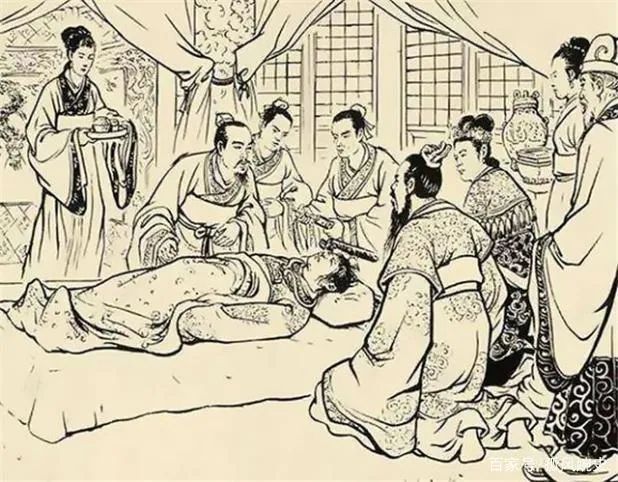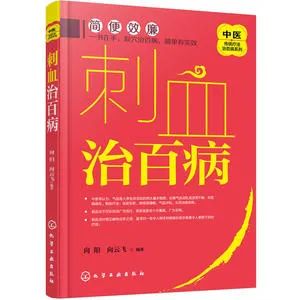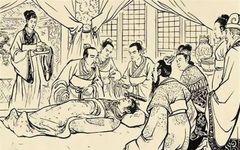The bloodletting therapy in Traditional Chinese Medicine (TCM) has a long history, originating in ancient times, established during the Qin and Han dynasties, developed in the Tang and Song dynasties, refined during the Jin and Yuan dynasties, matured in the Ming and Qing dynasties, and became active after the establishment of the People’s Republic of China.
Bloodletting therapy refers to the method of using tools such as the three-edged needle (san leng zhen) and skin needles to release a certain amount of blood from the patient’s superficial blood vessels or specific areas to achieve the purpose of preventing and treating diseases.
1. Originating in Ancient Times
The history of bloodletting therapy is long and can be traced back to the Neolithic period. In ancient times, ancestors used stone needles to pierce and release blood and pus to treat diseases (see Figure 1-1). The earliest written record of bloodletting therapy is found in the silk manuscripts unearthed from the Mawangdui Han tomb, specifically in the “Pulse Theory” where it states, “using bi (stone needle) to open the vessels,” meaning to pierce the vessels with a stone needle. Additionally, the “Fifty-Two Disease Formulas” records, “For the disease, first cut the skin above the egg, and pierce the area beside the scrotum with a stone needle,” indicating the use of stone needles to pierce the outer skin of the scrotum to treat diseases.
2. Established during the Qin and Han Dynasties
The birth of the “Huangdi Neijing” (Yellow Emperor’s Inner Canon) during the Qin and Han dynasties marked the formation of the theoretical basis for bloodletting therapy, laying the foundation for its development. This is mainly reflected in the systematic discussion of the theory of bloodletting, tools, methods, acupuncture points, treatment scope, contraindications, and mechanisms of action.
For example, the “Suwen: Blood and Qi Formations” states: “In treating diseases, one must first remove the blood, then address the suffering, observe the desires, and then drain the excess and replenish the deficiency.”
The “Lingshu: Small Needle Explanation” states: “To remove the stagnation, one must drain the blood vessels.” This indicates that the mechanism of bloodletting is to expel evil blood, eliminate turbid qi, open the meridians, and regulate blood and qi.
The “Lingshu: Official Needles” mentions methods such as “luo needle,” “great draining needle,” “hair needle,” “zan needle,” and “leopard pattern needle.”
The “Lingshu: Syncope” records: “For syncope with severe headache, if the pulse in front of and behind the ears is surging with heat, drain the blood and then treat the foot Shaoyang.”
The “Suwen: Acupuncture for Malaria” states: “For severe soreness and pain, if pressing it is unbearable, it is called ‘sui sui disease.’ Use a needle to pierce the bone to release blood, and it will be effective immediately.” This section also states: “When malaria causes fever, pierce the artery on the foot to open it and release blood, and it will immediately relieve the cold.”
The “Suwen: Discussion on Yin and Yang Correspondences” states: “If the blood is full, it should be drained.” The “Lingshu” also has a dedicated section on “Blood Vessels Theory,” discussing phenomena such as needle fainting, blood clots, dark blood, thin blood, pale blood, and symptoms like cyanosis and chest tightness during the bloodletting process.
The “Records of the Grand Historian” mentions that Bian Que used needle and stone methods to treat the corpse of Prince Guo, stating, “Use sharp needles and stones to access the external three Yang and five meetings,” which later research confirmed as accessing the Baihui (Hundred Meetings) point. Additionally, it records that when treating Duke Huan of Qi, he mentioned, “If the disease is in the blood vessels, it can be treated with needles and stones.”
The famous physician Hua Tuo also used bloodletting on the head to treat Cao Cao’s headache, achieving rapid results.

(The image shows Bian Que saving the Prince of Guo)
3. Developed in the Tang and Song Dynasties
During the Jin and Tang dynasties, bloodletting therapy was widely applied and developed rapidly. In the Jin dynasty, Huangfu Mi authored the “Classic of Acupuncture and Moxibustion,” which dedicated a section to “Strange Evil Blood Vessels,” discussing the pathological changes caused by strange evils stagnating in the vessels and the different responses caused by bloodletting.
In the Eastern Jin dynasty, Ge Hong recorded in the “Postscript to the Elbow” that “for treating acute throat and tongue pain, cut the skin behind the thumb to let blood flow, and it will heal immediately.” This method is still used in clinical practice today.
The “Essential Prescriptions Worth a Thousand Gold” proposed that bleeding from the middle of the wrist can treat lower back pain and can also cure “long-standing skin diseases immediately.” “For stomach malaria… it causes the patient to feel hungry and unable to eat, and when they eat, they feel full, pierce the foot Yangming and Taiyin horizontal vessels to release blood.” The “Essential Prescriptions of Wings” also records, “For throat obstruction, pierce the skin at the thumb’s claw to let blood flow, and it will heal within three large beans, piercing left to right and right to left.” The Tang dynasty’s Wang Tao in the “Secret Essentials of the External Chamber” also recorded cupping therapy. The Tang dynasty court physicians Zhang Wenzhong and Qin Minghe used acupuncture on the Baihui and Naohud points to cure Emperor Gaozong Li Zhi’s dizziness.
4. Refined during the Jin and Yuan Dynasties
During the Jin and Yuan dynasties, bloodletting therapy was further refined and developed, achieving breakthroughs in both theory and practice. Liu Wansu recorded in the “Suwen: Disease Mechanisms and Qi Preservation Collection” that “for great heat, continuous day and night, pierce the ten fingers to let blood, called the Eight Gates Great Drain,” and “for excessive heat that cannot be stopped, pierce the Hangu point to let blood.” The Eight Gates Great Drain is still used today to treat excess heat conditions.
Although Zhang Zihe did not specialize in acupuncture, he had considerable insights into bloodletting therapy. He advocated using the theory of the twelve meridians’ qi and blood to guide bloodletting therapy and regarded bloodletting as a type of sweating method. In the acupuncture cases recorded in the “Rumen Shiqin,” almost all were effective through bloodletting.
For example, treating “children with Dan tumors, edema, and toxic redness all over the body, which is the poison of evil heat, can use magnetic pieces to draw out purple blood, and the disease will heal immediately.” There was also treatment for eczema, “piercing over a hundred needles on the eczema until the blood is completely released.”
Li Dongyuan also had unique views and experiences regarding bloodletting therapy, using it not only for excess and heat conditions but also for certain deficiency conditions. For example, “piercing three inches below the Zusanli point to let blood” treated the deficiency of qi and blood, expanding the treatment scope of bloodletting therapy.
Zhu Zhenheng often used the three-edged needle for bloodletting in cases of heat and acute diseases to drain the excess.
Wang Guorui in the Yuan dynasty proposed in the “Bian Que’s Divine Response Acupuncture and Moxibustion” that acupuncture at the Weizhong point can treat diseases such as jaundice, wind toxin rashes, widespread itching, and visual impairment.
Wei Yilin in the Yuan dynasty recorded in the “Effective Methods of Medicine” that he treated “red eyes” by piercing the “red veins behind the ears,” which is an early record of the method of piercing and draining blood from the ears.
5. Matured during the Ming and Qing Dynasties
During the Ming and Qing dynasties, bloodletting therapy was continuously improved and developed, especially in the treatment of epidemic toxins, accumulating rich experience and making bloodletting therapy increasingly mature.
At the end of the Ming dynasty, Yang Jizhou authored the “Great Acupuncture Compendium,” which recorded many acupuncture points for bloodletting and the emergency treatment of diseases such as “stroke” and “children’s labor,” with abundant content on bloodletting, calling the emergency effect of bloodletting at the twelve jing points as the “wonderful secret of bringing the dead back to life.”
At the end of the Ming and beginning of the Qing dynasty, during the epidemic, Ye Tianshi, Zhao Xueming, and others applied bloodletting therapy to treat epidemics, achieving good results.
Qing dynasty physician Guo Zhizui authored the “Yuheng of Shazhang,” advocating the use of scraping and bloodletting to treat shazhang syndrome, which is considered a specialized work on bloodletting therapy for acute diseases, having a profound influence on later generations. Qing dynasty physician Xu Lingtai proposed in the “Source of Medicine” that “whenever there is evil in the blood vessels, it must be completely removed; if the blood is dark when it flows out, it must be changed to red; if it is red, it should stop; otherwise, the disease will not be eliminated and will instead cause harm.”
During the Republic of China, due to the introduction of Western medicine and criticism of old culture, TCM acupuncture faced rejection and even the danger of being abolished. However, in the folk community, due to the simplicity and effectiveness of bloodletting therapy, it continued to be widely used. For example, in 1931, the book “A Brief Guide to Acupuncture Treatment” by Wen Zhuqing included a section on “Bloodletting Techniques for Different Meridians,” which provided bloodletting treatment for corresponding distal points of different meridians.
The “Experimental Collection of Acupuncture Treatment” published by the Chinese Acupuncture Research Society also recorded treatments for the plague, using “twelve jing points, Chize, Weizhong, Taiyang, and others to let blood; for carbuncles, pierce the swollen toxic areas with a three-edged needle; for cholera, let blood from the fingertips, Qu Chi, Chize, Weizhong, Neiguan, Zhongwan; for “heart disease caused by foot qi,” pierce the leg veins to let out a lot of blood.” Fang Shen’an’s “Secret Transmission of Golden Needles” recorded treatment for foot poison and bruising, stating, “let out the toxic blood from the Weizhong point.”
6. Active in China
After the establishment of the People’s Republic of China, bloodletting therapy rapidly developed. Through further exploration, organization, and summarization, specialized works on bloodletting therapy such as “Bloodletting Therapy,” “Bloodletting Medical Mirror,” “Simple Folk Therapy – Bloodletting,” “Bloodletting Therapy,” “Chinese Bloodletting Diagrams,” and “Bloodletting in TCM” were published successively, bringing the research and application of bloodletting therapy to a new height. The clinical application of bloodletting therapy further expanded, especially with the establishment of the Bloodletting and Cupping Professional Committee of the Chinese Acupuncture Society, forming a national network for the research and application of bloodletting therapy, making the value of bloodletting therapy recognized and accepted by more people, playing its due role in the health care of the people.


